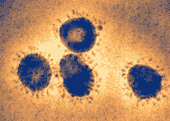Emerging infectious diseases threaten all forms of life on Earth. Many pathogens of great historical and contemporary significance have originated from other species, triggering pandemics, disrupting agriculture, and challenging efforts to conserve endangered wildlife. Despite decades of research on species-jumping pathogens, the most central questions in the field remain major stumbling blocks for societies that seek to mitigate their impacts. These questions include which pathogens are most likely to emerge, which hosts are most likely to share pathogens, and what will be the long-term fate of newly emerged pathogens? Part of the challenge is that emergence, by nature, transcends scientific disciplines, occurring as the product of human behaviour, environmental change, population, cellular and molecular biology, and evolution. Solutions therefore demand innovative pairing of theory and fundamental science with applied research and evidence-based policy-making.
Working with bat tissue samples from public health laboratories across the United States, I first constructed a data set of hundreds of rabies virus sequences from more than 20 bat species.
Using ecological and molecular sequence data from both bats and viruses, I developed a novel population genetic framework to quantify transmission rates between species. This analysis showed that, counter to the popular notion that rapid evolution in RNA viruses should make ecological overlap the best predictor of which host species share viruses, the genetic similarity of hosts constituted the strongest barrier to both initial infection and viral establishment in new species. The strong phylogenetic constraints on cross-species transmission move us closer to predicting the species origins of viral emergence.
My doctoral research used viral infections of bats to answer fundamental questions about pathogen emergence and to help guide control of a major zoonosis in the developing world. Working on bats was partly pragmatic-natural populations can easily be sampled in large numbers, and existing surveillance systems...


